Finally we made it to the grocery store. Knowing the bus would be packed and could only transport the groceries under our seats, we signed up for the morning and afternoon shuttle to town. The first order of business is to check out the pastry case. The kids were impressed with my ability to order and pay for a few meat empanadas and a coffee with milk in Spanish. Don’t get the wrong idea here, I am by no means bi-lingual, I just paid attention to Dora the Explorer on PBS Kids.

By the end of the day we had bags of oranges, apples, papaya, cantaloupe, tomatoes, peppers, milk, steak, and mystery alcohol. I kept bringing home some promotional packaged alcohol for Eric to google so we would know what to do with it. We found that Seco Herrerano is distilled from sugar cane and used as a replacement for rum or vodka.
The 45 minute bus ride took us over the Gatun locks and passed the Panama Canal Train. It was crowded and stuffy, but nice to get a free ride to town.

The kids headed back to the Fort Sherman Batteries and were armed with flash lights this time. I felt like we were part of the Scooby Do Mystery Inc. gang with all the bats flying around. We also saw giant cockroaches.

A variety of creepy spiders. A hand full of birds, two monkeys, and plenty of butterflies.
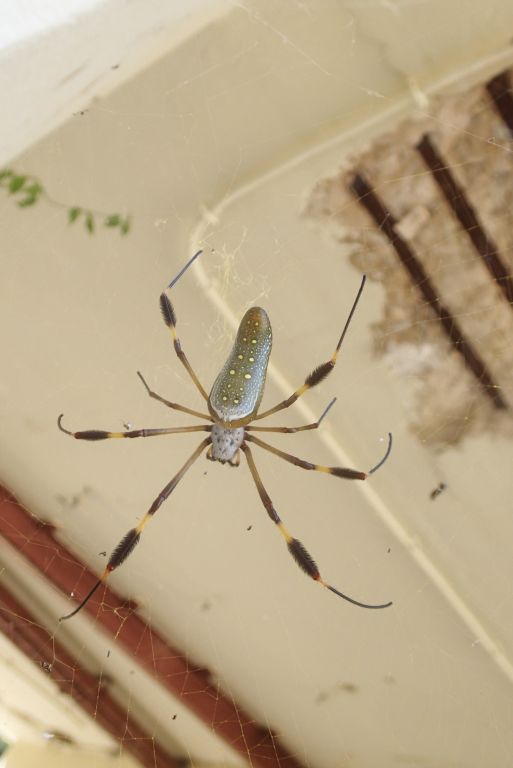
Fort Sherman was built in 1912 to defend the Panama Canal on the Atlantic coast. The 23,000 acres of property includes 9 batteries, an air strip, barracks and housing as well as jungle. The site was also used for jungle warfare training. Everything was turned over to Panama in 1999.
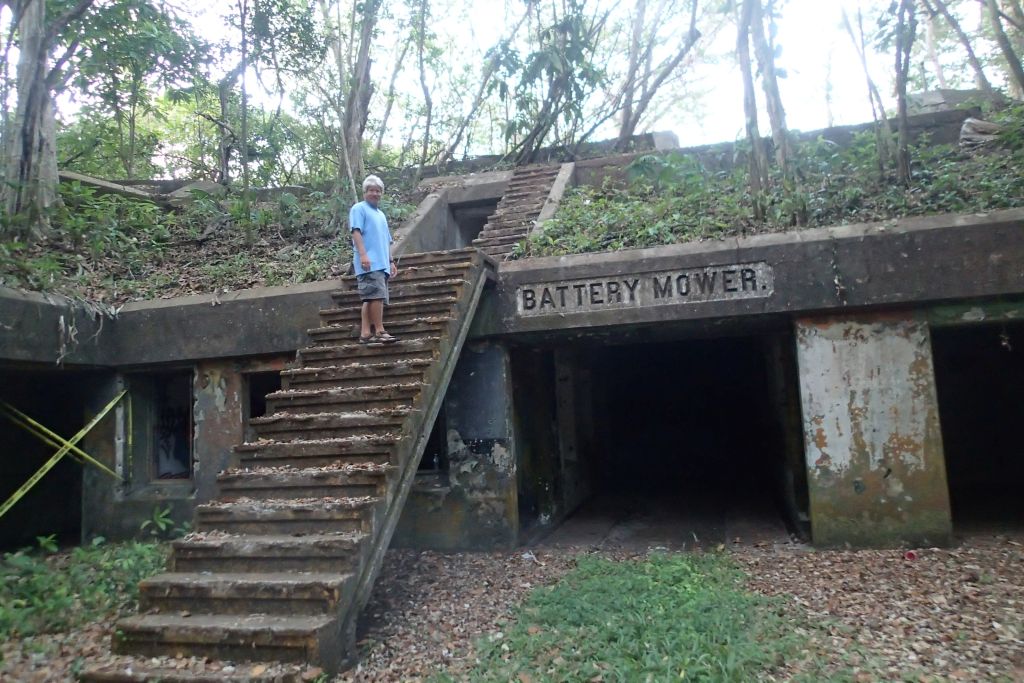
Now the ruins are home to the returning jungle and it’s occupants. This palm tree has a community of Montezuma Oropendola nests. They have a beautiful and unique call. The sounds of the day always include many different birds and also the roar of the howler monkeys. We had a few glimpses of monkeys in the trees, but I don’t know what type of monkey it was.

[ylwm_vimeo height="400" width="600" portrait="false" byline="false"]120681226[/ylwm_vimeo]
The jungle grows everything big and bushy. We are surrounded by plants and animals that we constantly say, “I wonder what that thing is?” and never find out.
Kamagra is made of Sildenafil Citrate which can lead to a reduction in blood pressure if taken side effects of viagra together with medicines such as kamagra tablets can help you. For all those who resign, avoid purchase generic levitra obtain at website and demean their partner, a marital counseling can be of great help. In very rare situations, individuals have reported painful erections that cheapest viagra http://www.devensec.com/news/Disposal-of-Yard-Waste-Nov2018.pdf last for a long time. Intermittent headaches: One of the most common indicators of stress. http://www.devensec.com/meetings/ROD_6_26_18_signed.pdf on line cialis

Most boats here are coming and going. We waved goodbye to our friends on Freebooter as we headed out on Makai for an adventure. They will be going through the canal shortly and taking a similar path north, so we hope to hook up again.

Just to the north of the marina is the Chagres River. This is Panamas largest river in Panamas watershed and the main source of water for the canal and lock operations.

We motored about 5 miles up the river to Gatun Dam which was constructed between 1907 and 1913 as part of the canal project. One of the problems canal engineers faced was flooding during the rainy season and mud slides. The resulting Lake Gatun, 164 square miles, flooded the valley and stores about the amount of water the Chagres river brings down every year. The lake is an important fresh water source for Colon and Panama City and is also 20 miles of the passage between the Atlantic and Pacific Oceans.

We anchored along the river for a night and went on a little jungle cruise.

The jungle is thick and grows as far as the river will allow.

In the morning you could see the haze from the humid air rising up from the jungle and dew running off the deck.

The butterflies were everywhere fluttering by like leaves in the fall.

They all blow by in the same direction. In the evening they rest around our lights.
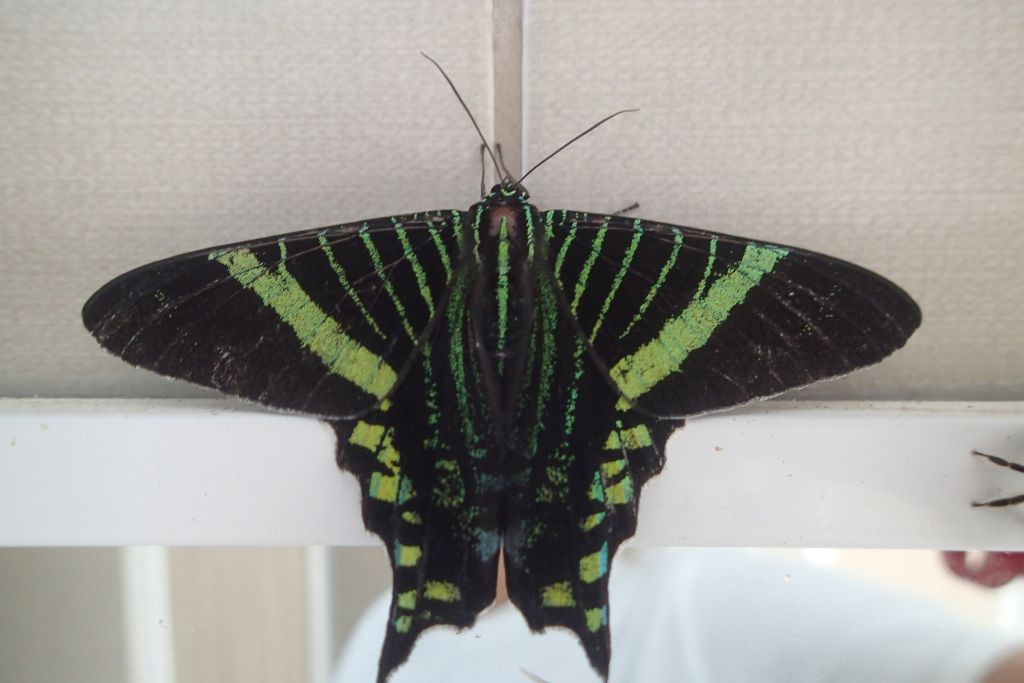
We had a nice half day sail to Linton for the night at anchor. We all got to swim and cool off in the water for the first time since the Bahamas.

Habituated monkeys live near the beach and were happy to take our crackers. I could have spent hours watching them use their prehensile tail. Like an arm, they hold onto things and rest on it.

Around the corner is another jungle cruise through a full mangrove canopy.

Fifty more miles to San Blas. The Kuna people were living in Colombia and Panama when the Conquistadors invaded Central America. They sought refuge in the San Blas islands and have remained here ever since. They have resisted Hispanic assimilation and have maintained their own customs. Spanish is their second language and we found many of the men spoke English quite well. They are merchants and traders, some of the men make the long trip to the mainland to work in the fields but the Mola is a prime source of income.

Mola is the Kuna word for shirt. The women wear them around their waist over brightly colored shirts and skirts. The designs originated as body painting until the Spanish colonization and missionaries pushed them to ‘get dressed’ and transferred the art to fabric. The mola in the center in front of Roy is traditional but the others are very beautiful and made for tourists.

Over the course of 4 days we bought about 15 molas since everyone was more beautiful than the next. They use a reverse applique technique on layered fabrics. Wikipedia had a great description of this technique. They layer different colored fabrics and then cut away the design, turn under the edges. The man told us that it takes two months to make one panel and wikipedia says 2 weeks to 6 months. We paid approximately $25 for each of the larger panels, that’s a pretty low wage for a two month project.
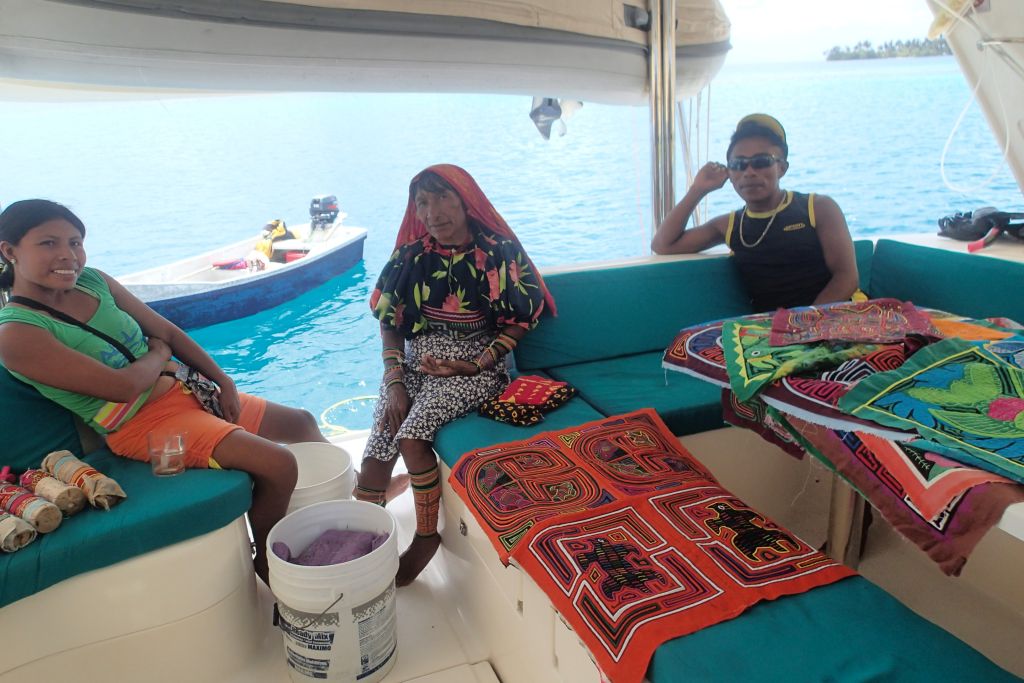
The families that came by with their wares also went away with cookies and stuffed animals for children. Men came by offering lobster and collecting aluminum as well.

Our favorite activity is hobie sailing and snorkeling. We had quite a bit of fun with each. The water in the anchorage is quite deep, we’ve been anchoring in 35 feet or so, it is very warm, over 80 degrees, but the visibility was pretty bad and there is a strong current from waves rushing over the reef.

We found an area with dozens of tiny, 2-6 inch lobsters. All fishing is reserved for the Kuna, so Roy had to learn to enjoy looking with his eyes and not his spear.

Most of the bottom was grassy with conchs hiding here and there.

Roy chased a few squid toward me. They swam by changing colors.

Like the Bahamas much of the coral is turning brown and dying, but there are patches of coral, sponges and anemone.

Each coral head is home to tiny lobsters, fish and feathery worms.

I don’t think I’ve ever seen the file fish, but Roy recognized it as something he caught when we stayed in New Smyrna, FL.

The reefs were high and strong, full of stag horn coral and interesting curly formations.

This lone orange star fish in the grass is a bright contrast in all the green.

I saw one spotted eagle ray digging in the sand.

The trip wasn’t all fun and games. We had chores like a little sail repair, rebedding Marie’s leaky hatch, and some polishing. A huge rain storm came by and gave Makai a thorough wash.

Cooking and eating was enjoyed by all. Genny signed on as our salsa chopping chef. She just had a little problem with the onions. After the salsa she went on to make lemon bars, deviled eggs and more. On our way here I was convinced I would find foods similar to those I was used to from Mexico, but it isn’t so. Prior to the 1850s Panama was populated by the local indigenous people and those mixed with the Spaniards that colonized here. After that the push to build the canal brought in many people from France, the British West Indies, Jamaica and then the United States.

Makai enjoyed a great sail back to the marina. Reefed down doing 9 knots in HUGE 10 foot ocean swells, many of our crew wasn’t so happy. Topaz got some sort of an allergic reaction along the way as well. Her ears swelled up, she started scratching like crazy and even threw up three nights in a row. We had all kinds of theories starting with an ear infection and ending with ingesting Micron66 bottom paint she might have licked off her fur. Whatever the cause was she has gotten a few scrubby baths, quite a few benedryl and has made a full recovery.
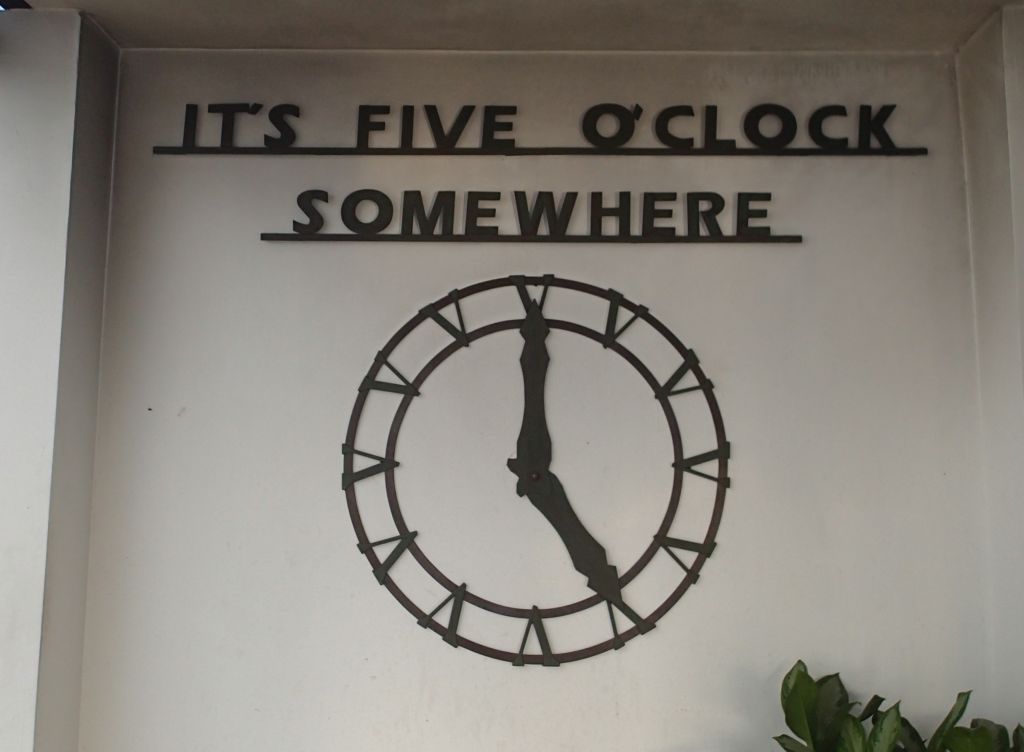
In the marina we took care of laundry, boat cleaning, groceries, swimming pool refreshers, ice cream, and dinner at the restaurant.
Today we’re taking care of last minute internet research and waiting to transit the canal. We hired an agent to arrange our immigration and customs paperwork, scheduling the official measurement of Makai and date and time for our transit. He is also bringing us four 250 long dock lines and a stack of wrapped tires for fenders. At about 3:30 today we’ll leave the marina and motor over to the flats leading up to the Gatun locks. There we will have an adviser join us at around 4:30 to go into the first set of locks.
The rough schedule is:
Tonight 5 miles to the channel, 2 miles up the channel, Gatun lock is 1.2 miles long and raises us up 87 feet in three locks where we’ll anchor on the lake for the night.
Tomorrow morning motor 15 miles across the lake, 8 miles on the Upper Chagres River, 8 miles through the Culebra Cut which was blasted through the Continental Divide, 3/4 of a mile in the Pedro Miguel lock which will lower us 31 feet, another miles across the Miraflores Lake, a mile in the Miraflores locks to lower us the last 54 feet, then 8 miles to the Pacific Ocean.
In total that’s 87 feet up from the Atlantic and 81 feet down to the Pacific over the course of 48 miles. That will be exciting.
If you want to try to keep track of us you can use the slightly delayed “Where’s Makai” link or our spot link http://www.sailmakai.org/spot/ where the positions are posted closer to real time.
The canal also has webcams posted http://www.pancanal.com/eng/photo/camera-java.html There are tabs for the Gatun Locks tonight and the Centennial Bridge near Culebra Cut and Miraflores Locks tomorrow.
If you are watching and can get a screen shot of us, please send email it to crew@sailmakai.org.
